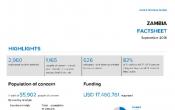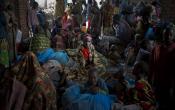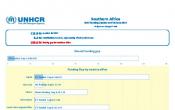Zambia
Operation: Zambia
Location
{"longitude":28,"latitude":-13,"zoom_level":0}
Latest update of camps and office locations 21 Nov 2016. By clicking on the icons on the map, additional information is displayed.
Key Figures
| 2017 planning figures | |
| 85% | of primary school-aged refugee children in settlements will be enrolled in school |
| 70% | of unaccompanied and separated children will have best interests determination procedures initiated or completed |
| 50% | of refugees in settlements in need of resettlement will be resettled |
| 2015 end-year results | |
| 6,506 | refugee children were enrolled in primary school |
| 100% | of people of concern had access to primary health care and to HIV services |
| 1,749 | people with specific needs were provided with cash assistance |
| 923 | refugees were submitted for resettlement |
Latest Updates
People of Concern
10%
Increase in
2016
2016
| 2016 | 57,209 |
| 2015 | 52,179 |
| 2014 | 50,216 |

[["Refugees",29350],["Asylum-seekers",3319],["Others of concern",24540]]
Loading ...
Zambia
< Back
2016
{"categories":[2012,2013,2014,2015,2016,2017],"budget":[17.91054247,14.99645596,13.77666413,19.5134076,17.61131682,13.60990976],"expenditure":[8.62723189,8.00941753,9.46195797,8.98553227,10.45134148,null]}
{"categories":[2012,2013,2014,2015,2016,2017],"p1":[17.91054247,14.99645596,13.77666413,19.5134076,17.61131682,13.60990976],"p2":[null,null,null,null,null,null],"p3":[null,null,null,null,null,null],"p4":[null,null,null,null,null,null]}
{"categories":[2012,2013,2014,2015,2016,2017],"p1":[8.62723189,8.00941753,9.46195797,8.98553227,10.45134148,null],"p2":[null,null,null,null,null,null],"p3":[null,null,null,null,null,null],"p4":[null,null,null,null,null,null]}
Loading ...
CHOOSE A YEAR
- 2015
- 2016
- 2017
Working environment
In December 2016, the Zambian Commissioner for Refugees and UNHCR handed over to the Department of Resettlement and development actors – led by UNDP – the socio-economic components of the local integration programme for former Angolan and Rwandan refugees. The Office of the Commissioner for Refugees and UNHCR will continue to support asylum processes, such as processing and issuance of documentation needed for local integration.The Government of Zambia made a number of commitments to obtain durable solutions and improve the lives of refugees in 2016, such as allowing more flexibility with regards to access to livelihood opportunities, as well as access to local integration opportunities for refugees in Zambia.
Population trends
- Zambia was hosting 57,200 people of concern at the end of 2016, including 29,350 refugees, 3,320 asylum-seekers and 24,540 former refugees.
- Zambia received 3,949 new asylum-seekers (33% increase from 2015), mainly from the Democratic Republic of the Congo (2,900) and Burundi (840).
Achievements and impact
- UNHCR advised on the draft Refugee Bill.
- A study on the status of stateless people in Zambia was completed.
- Livelihood support was extended to 600 new farmers as part of the local integration programme.
Unmet needs
- Verification and profiling of the refugee population needs to be conducted.
- A number of vulnerable children were unable to be supported to enrol or maintain their attendance in schools.
Operational context and population trends
The political situation in Zambia is expected to remain stable throughout 2016 - 2017, though periodic tensions are anticipated as the country approaches the general elections in the last quarter of 2016. As a result, attention is likely to shift away from refugee related issues, including the passing of the Refugee Act. Overall protection concerns relate to Zambia’s encampment policy, which stems from Zambia’s reservations to the 1951 Refugee Convention, and has resulted in restrictions on freedom of movement and the right to work for refugees.UNHCR’s 2016 plan is based on the following assumptions:
- The population of concern to UNHCR is expected to gradually decrease over the next two years, due mainly to the repatriation of up to 2,000 Angolans and the progress achieved through local integration (relocation to the settlements) of some 6,000 Angolans.
- The arrival rate of asylum-seekers, particularly from the Democratic Republic of Congo (DRC), is expected to reach around 750 per year, based on past trends.
- The total population of concern towards the end of 2017 is estimated to stand at 37,266 individuals: 28,875 refugees, 540 asylums-seekers and 7,851 other people of concern (former Angolan and Rwandans refugees whose status ceased in 2012 and 2013 respectively).
Key priorities in 2016
The operation will continue providing protection and basic essential services on a reduced scale while continuing to search for durable solutions. Possible solutions for Congolese refugees are limited due to the volatile security situation in the DRC which makes voluntary repatriation impossible for many.The refugee programme will prioritize the following areas:
- Child protection – Strengthening the capacity of partners to conduct best interest determination procedures and identify solutions for unaccompanied minors
- Prevention of detention – Implementing UNHCR’s detention strategy, with special emphasis on preventing detention of children and identifying alternatives to detention
- SGBV – Organizing outreach and sensitization activities on SGBV for affected communities
- Statelessness – Supporting the Government to fulfil its pledge of signing the 1961 Statelessness Convention
- Self-reliance – Organizing activities to facilitate UNHCR’s progressive disengagement from providing direct assistance to refugees
- Education – Distributing scholarships for unaccompanied minors and other vulnerable children.
- Camp facilities – Ensuring that refugees in the settlements have access to potable water and health services.





